Evaluating the Hydrologic Performance of Low Impact Development Scenarios in a Micro Urban Catchment
Abstract
:1. Introduction
2. Materials and Methods
2.1. Study Area and Data
2.2. Model Description
2.3. Goodness-of-Fit Test
2.4. Designed Scenarios
3. Results
3.1. Calibration and Verification
3.2. LID Scenarios Optimization
3.3. Performance of Scenarios
4. Discussion
4.1. Hydrologic Performance of LID in Micro Urban Catchments
4.2. Applicability and Implications
4.3. Limitations and Uncertainties
5. Conclusions
Acknowledgments
Author Contributions
Conflicts of Interest
References
- Ebrahimian, A.; Gulliver, J.S.; Wilson, B.N. Effective impervious area for runoff in urban watersheds. Hydrol. Process. 2016, 30, 3717–3729. [Google Scholar] [CrossRef]
- Carpenter, S.R.; Caraco, N.F.; Correll, D.L.; Howarth, R.W.; Sharpley, A.N.; Smith, V.H. Nonpoint pollution of surface waters with phosphorus and nitrogen. Ecol. Appl. 1998, 8, 559–568. [Google Scholar] [CrossRef]
- Olang, L.O.; Furst, J. Effects of land cover change on flood peak discharges and runoff volumes: Model estimates for the Nyando River Basin, Kenya. Hydrol. Process. 2011, 25, 80–89. [Google Scholar] [CrossRef]
- Yao, L.; Chen, L.D.; Wei, W. Exploring the linkage between urban flood risk and spatial patterns in small urbanized catchments of Beijing, China. Int. J. Environ. Res. Public Health 2017, 14, 239. [Google Scholar] [CrossRef] [PubMed]
- Chen, J.; Theller, L.; Gitau, M.W.; Engel, B.A.; Harbor, J.M. Urbanization impacts on surface runoff of the contiguous United States. J. Environ. Manag. 2017, 187, 470–481. [Google Scholar] [CrossRef] [PubMed]
- Tsihrintzis, V.A.; Hamid, R. Urban stormwater quantity/quality modeling using the SCS method and empirical equations. J. Am. Water Resour. Assoc. 1997, 33, 163–176. [Google Scholar] [CrossRef]
- Miller, J.D.; Kim, H.; Kjeldsen, T.R.; Packman, J.; Grebby, S.; Dearden, R. Assessing the impact of urbanization on storm runoff in a peri-urban catchment using historical change in impervious cover. J. Hydrol. 2014, 515, 59–70. [Google Scholar] [CrossRef] [Green Version]
- Tong, S.T.; Chen, W. Modeling the relationship between land use and surface water quality. J. Environ. Manag. 2002, 66, 377–393. [Google Scholar] [CrossRef]
- Zoppou, C. Review of urban storm water models. Environ. Model. Softw. 2001, 16, 195–231. [Google Scholar] [CrossRef]
- Granata, F.; Gargano, R.; de Marinis, G. Support vector regression for rainfall-runoff modeling in urban drainage: A comparison with the EPA’S storm water management model. Water 2016, 8, 69. [Google Scholar] [CrossRef]
- Hibbs, B.J.; Sharp, J.M. Hydrogeological impacts of urbanization. Environ. Eng. Geosci. 2012, 18, 3–24. [Google Scholar] [CrossRef]
- Ahiablame, L.M.; Engel, B.A.; Chaubey, I. Effectiveness of low impact development practices: Literature review and suggestions for future research. Water Air Soil Pollut. 2012, 223, 4253–4273. [Google Scholar] [CrossRef]
- Ji, C.; Li, L. Research on sponge city construction in Lin Yi city. In Proceedings of the 2016 International Conference on Education, Management, Computer and Society, Shenyang, China, 1–3 January 2016. [Google Scholar]
- Baek, S.S.; Choi, D.H.; Jung, J.W.; Lee, H.J.; Lee, H.; Yoon, K.S.; Cho, K.H. Optimizing low impact development (lid) for stormwater runoff treatment in urban area, Korea: Experimental and modeling approach. Water Res. 2015, 86, 122–131. [Google Scholar] [CrossRef] [PubMed]
- Rosa, D.J.; Clausen, J.C.; Dietz, M.E. Calibration and verification of SWMM for low impact development. JAWRA J. Am. Water Resour. Assoc. 2015, 51, 746–757. [Google Scholar] [CrossRef]
- Bedan, E.S.; Clausen, J.C. Stormwater runoff quality and quantity from traditional and low impact development watersheds. JAWRA J. Am. Water Resour. Assoc. 2009, 45, 998–1008. [Google Scholar] [CrossRef]
- Zare, S.O.; Saghafian, B.; Shamsai, A. Multi-objective optimization for combined quality-quantity urban runoff control. Hydrol. Earth Syst. Sci. 2012, 16, 4531–4542. [Google Scholar] [CrossRef]
- Kong, F.; Ban, Y.; Yin, H.; James, P.; Dronova, I. Modeling stormwater management at the city district level in response to changes in land use and low impact development. Environ. Model. Softw. 2017, 95, 132–142. [Google Scholar] [CrossRef]
- Zhang, X.Q.; Guo, X.Y.; Hu, M.C. Hydrological effect of typical low impact development approaches in a residential district. Nat. Hazards 2016, 80, 389–400. [Google Scholar] [CrossRef]
- Jia, H.; Lu, Y.; Yu, S.L.; Chen, Y. Planning of LID–BMPs for urban runoff control: The case of Beijing Olympic Village. Sep. Purif. Technol. 2012, 84, 112–119. [Google Scholar] [CrossRef]
- Shon, T.S.; Kim, M.E.; Joo, J.S.; Jo, D.J.; Shin, H.S. Analysis of the characteristics of non-point pollutant runoff applied LID techniques in industrial area. Desalin. Water Treat. 2013, 51, 4107–4117. [Google Scholar] [CrossRef]
- Yao, L.; Wei, W.; Chen, L. How does imperviousness impact the urban rainfall-runoff process under various storm cases? Ecol. Indic. 2016, 60, 893–905. [Google Scholar] [CrossRef]
- Elliott, A.; Trowsdale, S.A. A review of models for low impact urban stormwater drainage. Environ. Model. Softw. 2007, 22, 394–405. [Google Scholar] [CrossRef]
- Tsihrintzis, V.A.; Hamid, R. Runoff quality prediction from small urban catchments using SWMM. Hydrol. Process. 1998, 12, 311–329. [Google Scholar] [CrossRef]
- Gao, J.; Wang, R.; Huang, J.; Liu, M. Application of BMP to urban runoff control using SUSTAIN model: Case study in an industrial area. Ecol. Model. 2015, 318, 177–183. [Google Scholar] [CrossRef]
- Chen, C.-F.; Sheng, M.-Y.; Chang, C.-L.; Kang, S.-F.; Lin, J.-Y. Application of the SUSTAIN model to a watershed-scale case for water quality management. Water 2014, 6, 3575–3589. [Google Scholar] [CrossRef]
- Mao, X.; Jia, H.; Yu, S.L. Assessing the ecological benefits of aggregate LID-BMPs through modelling. Ecol. Model. 2017, 353, 139–149. [Google Scholar] [CrossRef]
- China Environmental Protection Administration. Analyses Methods for Monitoring Water and Wastewater, 4th ed.; Environmental Science Press: Beijing, China, 2002.
- Mahler, B.J.; Van Metre, P.C.; Bashara, T.J.; Wilson, J.T.; Johns, D.A. Parking lot sealcoat: An unrecognized source of urban polycyclic aromatic hydrocarbons. Environ. Sci. Technol. 2005, 39, 5560–5566. [Google Scholar] [CrossRef] [PubMed]
- Li, C.; Liu, M.; Hu, Y.; Gong, J.; Sun, F.; Xu, Y. Characterization and first flush analysis in road and roof runoff in Shenyang, China. Water Sci. Technol. 2014, 70, 397–406. [Google Scholar] [CrossRef] [PubMed]
- Eriksson, E.; Baun, A.; Scholes, L.; Ledin, A.; Ahlman, S.; Revitt, M.; Noutsopoulos, C.; Mikkelsen, P.S. Selected stormwater priority pollutants—A European perspective. Sci. Total Environ. 2007, 383, 41–51. [Google Scholar] [CrossRef] [PubMed]
- Shoemaker, L.; Riverson, J.; Alvi, K.; Zhen, J.X.; Paul, S.; Rafi, T. Sustain: A Framework for Placement of Best Management Practices in Urban Watersheds to Protect Water Quality; US Environmental Protection Agency: Washington, DC, USA, 2009.
- Lee, J.G.; Selvakumar, A.; Alvi, K.; Riverson, J.; Zhen, J.X.; Shoemaker, L.; Lai, F.-H. A watershed-scale design optimization model for stormwater best management practices. Environ. Model. Softw. 2012, 37, 6–18. [Google Scholar] [CrossRef]
- Ouyang, W.; Guo, B.; Hao, F.; Huang, H.; Li, J.; Gong, Y. Modeling urban storm rainfall runoff from diverse underlying surfaces and application for control design in beijing. J. Environ. Manag. 2012, 113, 467–473. [Google Scholar] [CrossRef] [PubMed]
- Li, C.; Liu, M.; Hu, Y.; Gong, J.; Xu, Y. Modeling the quality and quantity of runoff in a highly urbanized catchment using storm water management model. Pol. J. Environ. Stud. 2016, 25, 1573–1581. [Google Scholar] [CrossRef]
- Arabi, M.; Govindaraju, R.S.; Hantush, M.M. A probabilistic approach for analysis of uncertainty in the evaluation of watershed management practices. J. Hydrol. 2007, 333, 459–471. [Google Scholar] [CrossRef]
- Zhao, D.; Chen, J.; Wang, H.; Tong, Q. Application of a sampling based on the combined objectives of parameter identification and uncertainty analysis of an urban rainfall-runoff model. J. Irrig. Drain. Eng. 2012, 139, 66–74. [Google Scholar] [CrossRef]
- Xia, J.; Zhang, Y.Y.; Xiong, L.H.; He, S.; Wang, L.F.; Yu, Z.B. Opportunities and challenges of the sponge city construction related to urban water issues in China. Sci. China-Earth Sci. 2017, 60, 652–658. [Google Scholar] [CrossRef]
- Li, H.; Ding, L.Q.; Ren, M.L.; Li, C.Z.; Wang, H. Sponge city construction in china: A survey of the challenges and opportunities. Water 2017, 9, 594. [Google Scholar] [CrossRef]
- Ministry of Housing and Urban-Rural Development. Technical Guide for Sponge Cities—Water System Construction of Low Impact Development; China Building Industry Press: Beijing, China, 2014; p. 99.
- Deb, K.; Pratap, A.; Agarwal, S.; Meyarivan, T. A fast and elitist multiobjective genetic algorithm: Nsga-ii. IEEE Trans. Evol. Comput. 2002, 6, 182–197. [Google Scholar] [CrossRef]
- Granata, F.; Papirio, S.; Esposito, G.; Gargano, R.; de Marinis, G. Machine learning algorithms for the forecasting of wastewater quality indicators. Water 2017, 9, 105. [Google Scholar] [CrossRef]
- Liu, Y.; Ahiablame, L.M.; Bralts, V.F.; Engel, B.A. Enhancing a rainfall-runoff model to assess the impacts of bmps and lid practices on storm runoff. J. Environ. Manag. 2015, 147, 12–23. [Google Scholar] [CrossRef] [PubMed]
- Chui, T.F.M.; Liu, X.; Zhan, W. Assessing cost-effectiveness of specific lid practice designs in response to large storm events. J. Hydrol. 2016, 533, 353–364. [Google Scholar] [CrossRef]
- Jia, H.; Yao, H.; Tang, Y.; Yu, S.L.; Field, R.; Tafuri, A.N. Lid-bmps planning for urban runoff control and the case study in China. J. Environ. Manag. 2015, 149, 65–76. [Google Scholar] [CrossRef] [PubMed]
- Trowsdale, S.A.; Simcock, R. Urban stormwater treatment using bioretention. J. Hydrol. 2011, 397, 167–174. [Google Scholar] [CrossRef]
- Kim, M.H.; Sung, C.Y.; Li, M.-H.; Chu, K.-H. Bioretention for stormwater quality improvement in Texas: Removal effectiveness of escherichia coli. Sep. Purif. Technol. 2012, 84, 120–124. [Google Scholar] [CrossRef]
- Jeon, D.J.; Ki, S.J.; Baek, S.S.; Cha, Y.; Cho, K.H.; Yoon, K.S.; Shin, H.S.; Kim, J.H. Assessing the efficiency of aggregate low impact development (lid) at a small urbanized sub-catchment under different storm scenarios. Desalin. Water Treat. 2017, 86, 1–8. [Google Scholar] [CrossRef]
- Rauch, W.; Ledin, A.; Eriksson, E.; Deletic, A.; Hunt Iii, W.F. Stormwater in urban areas. Water Res. 2012, 46, 6588. [Google Scholar] [CrossRef]
- Angrill, S.; Petit-Boix, A.; Morales-Pinzón, T.; Josa, A.; Rieradevall, J.; Gabarrell, X. Urban rainwater runoff quantity and quality—a potential endogenous resource in cities? J. Environ. Manag. 2017, 189, 14–21. [Google Scholar] [CrossRef] [PubMed]
- Jia, H.F.; Wang, X.W.; Ti, C.P.; Zhai, Y.Y.; Field, R.; Tafuri, A.N.; Cai, H.H.; Yu, S.L. Field monitoring of a LID-BMP treatment train system in china. Environ. Monit. Assess. 2015, 187, 18. [Google Scholar] [CrossRef] [PubMed]
- Dietz, M.E. Low impact development practices: A review of current research and recommendations for future directions. Water Air Soil Pollut. 2007, 186, 351–363. [Google Scholar] [CrossRef]
- Hsieh, C.H.; Davis, A.P. Evaluation and optimization of bioretention media for treatment of urban storm water runoff. J. Environ. Eng. 2005, 131, 1521–1531. [Google Scholar] [CrossRef]
- Qin, H.P.; Li, Z.X.; Fu, G.T. The effects of low impact development on urban flooding under different rainfall characteristics. J. Environ. Manag. 2013, 129, 577–585. [Google Scholar] [CrossRef] [PubMed] [Green Version]
- Park, D.; Jang, S.; Roesner, L.A. Evaluation of multi-use stormwater detention basins for improved urban watershed management. Hydrol. Process. 2014, 28, 1104–1113. [Google Scholar] [CrossRef]
- Dietz, M.E.; Clausen, J.C. Stormwater runoff and export changes with development in a traditional and low impact subdivision. J. Environ. Manag. 2008, 87, 560–566. [Google Scholar] [CrossRef] [PubMed]
- Line, D.E.; White, N.M. Runoff and pollutant export from a lid subdivision in North Carolina. J. Environ. Eng. 2016, 142, 04015052. [Google Scholar] [CrossRef]
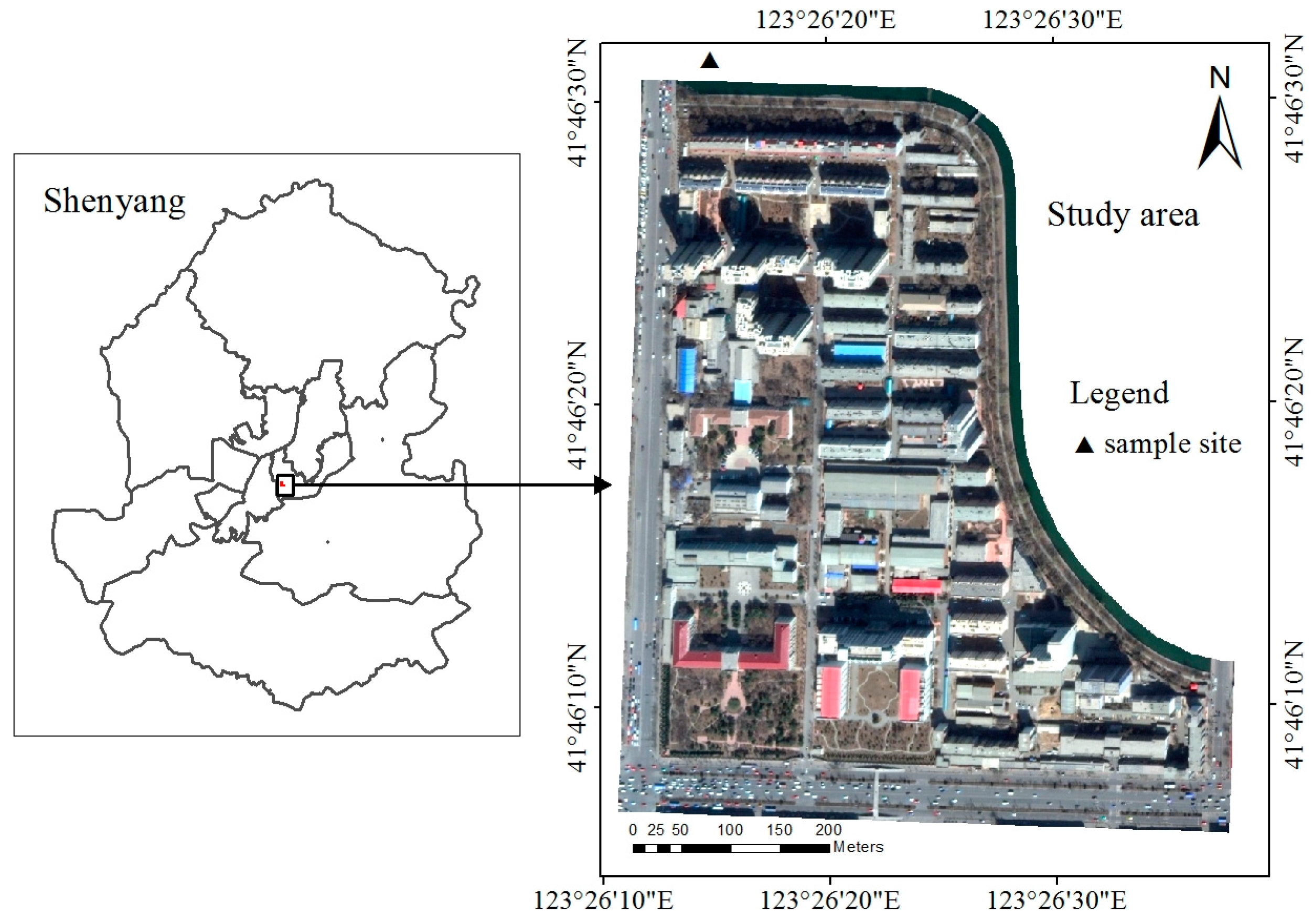
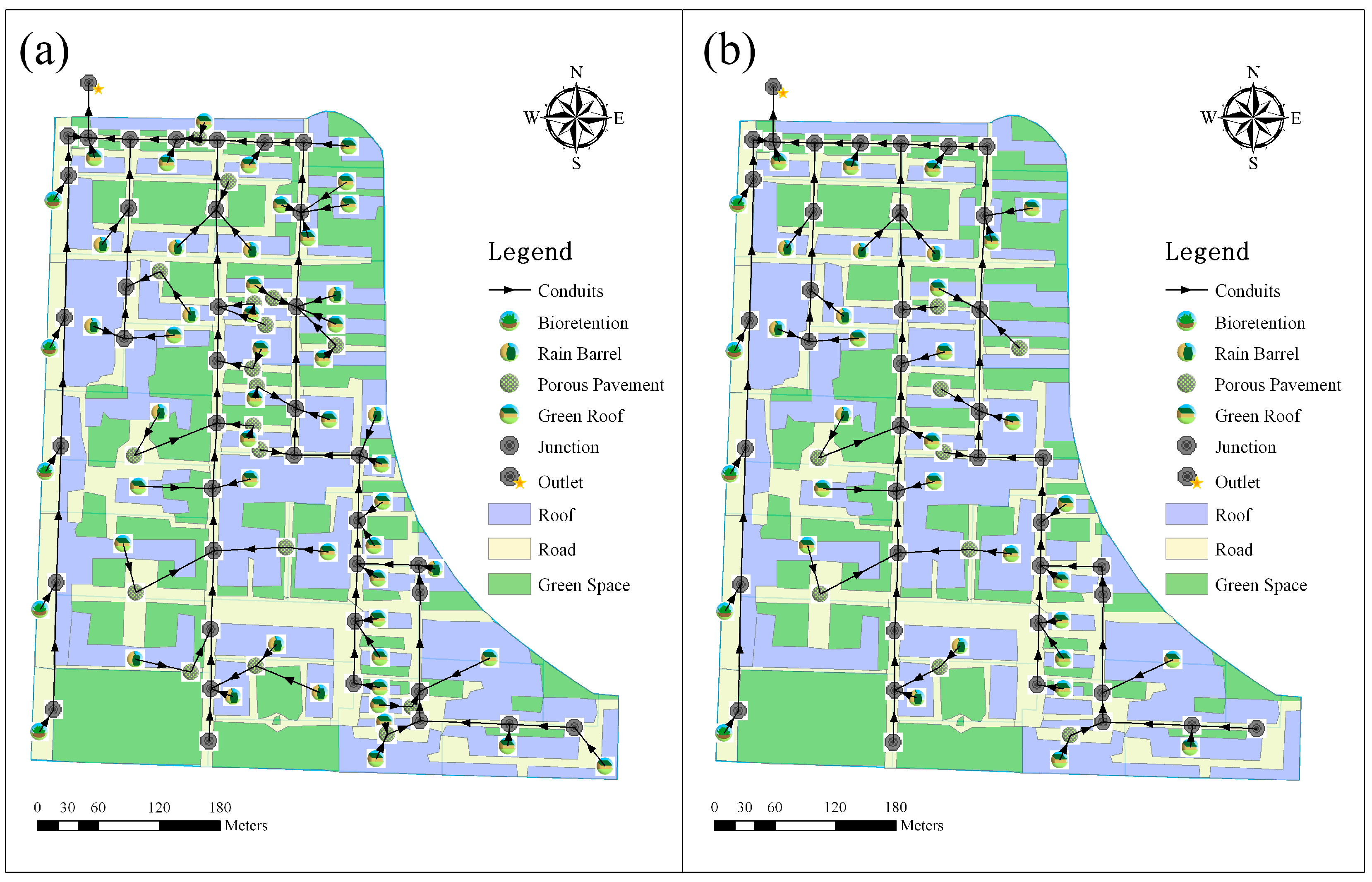
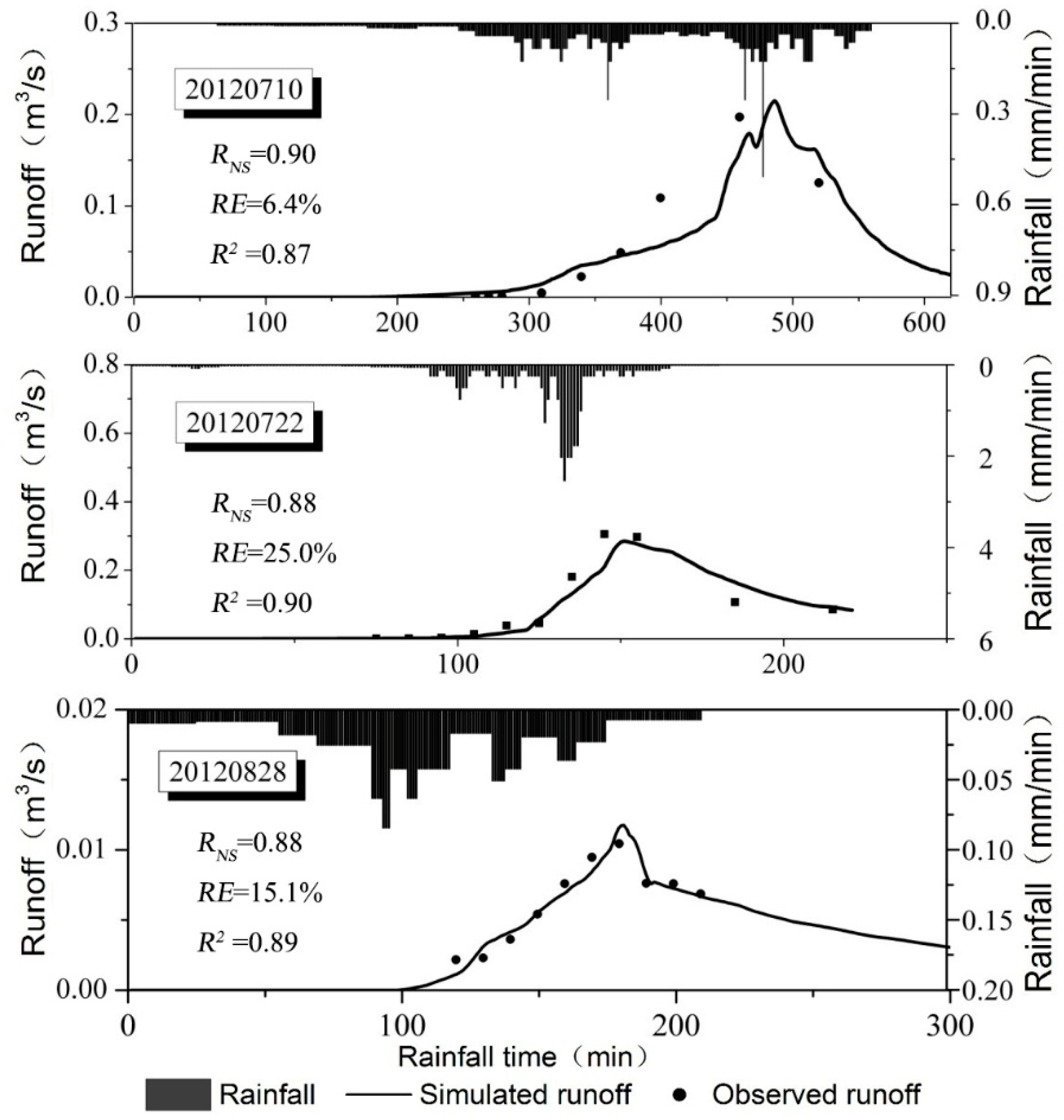
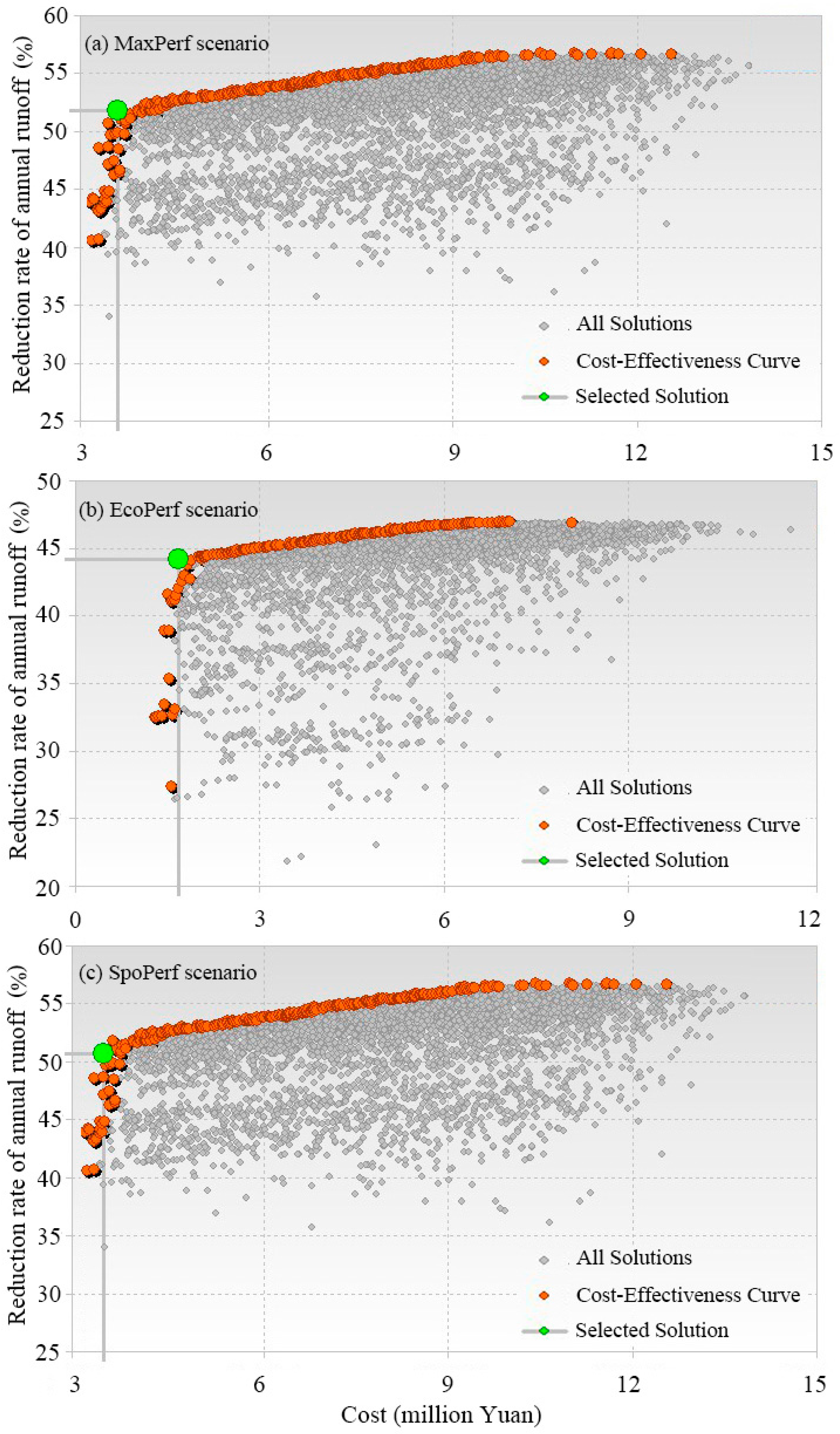

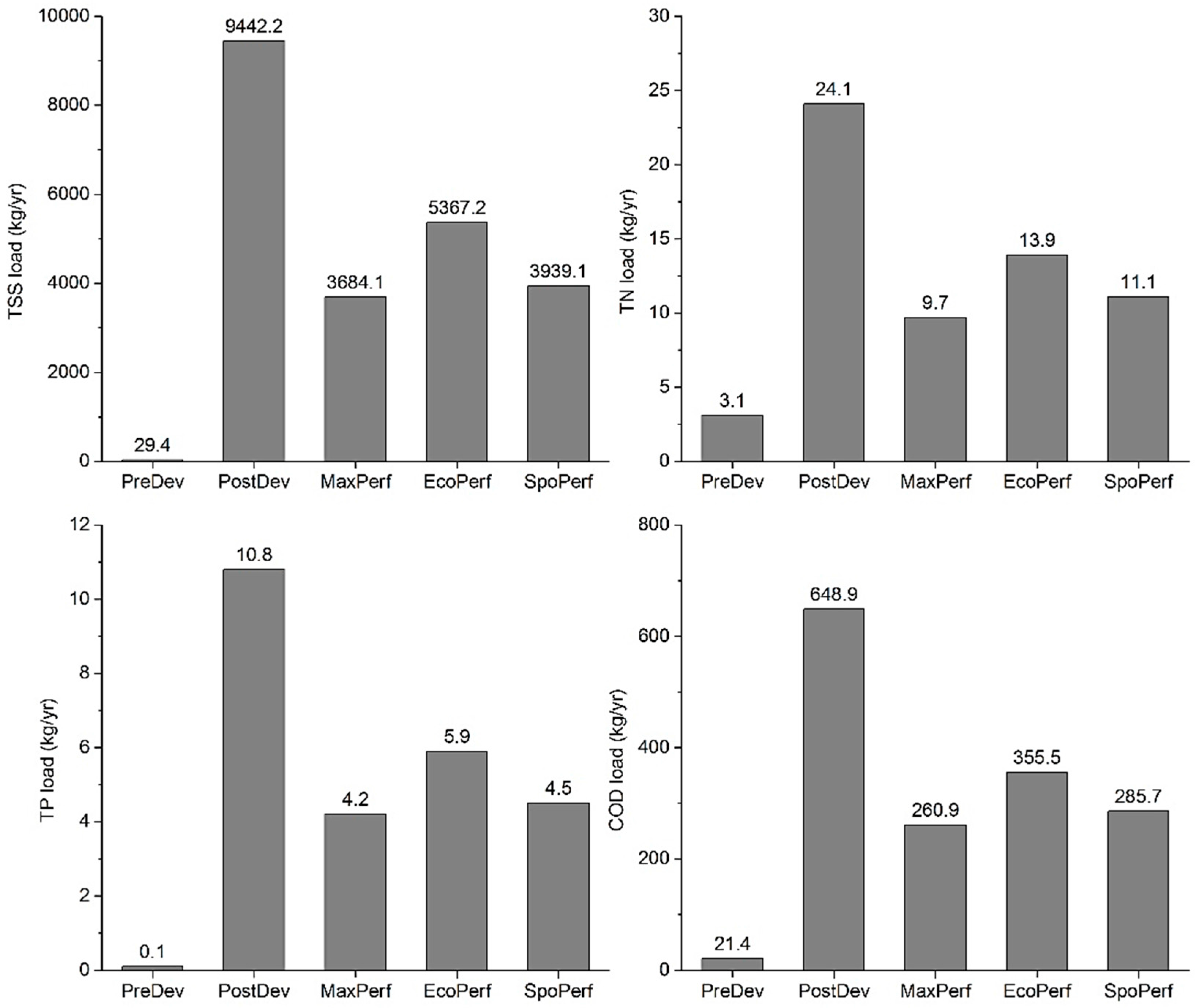
| Date (d-m-y) | Rainfall (mm) | Duration (h) | Average Intensity (mm/h) | Max Rainfall Intensity (mm/h) | Antecedent dry Weather Period (day) |
|---|---|---|---|---|---|
| 10 July 2012 | 16.0 | 6.7 | 2.4 | 5.0 | 5 |
| 22 July 2012 | 33.8 | 2.8 | 12.1 | 28.7 | 10 |
| 28 August 2012 | 4.6 | 3.5 | 1.3 | 2.4 | 9 |
| LIDs | Cost Rang in TGSCU | Total Cost in Shenyang |
|---|---|---|
| Bioretention (Yuan/m2) | 150–800 | 500 |
| Rain Barrel (Yuan/unit) | 50–150 | 110 |
| Porous Pavement (Yuan/m2) | 60–200 | 130 |
| Green Roof (Yuan/m2) | 100–300 | 200 |
| Pollutants | Events | Goodness of Fit Indicators | ||
|---|---|---|---|---|
| RNS | RE (%) | R2 | ||
| TSS | 20120710 | 0.88 | 22.4 | 0.90 |
| 20120722 | 0.96 | 12.1 | 0.74 | |
| 20120828 | 0.75 | 11.8 | 0.75 | |
| TP | 20120710 | 0.91 | 22.7 | 0.96 |
| 20120722 | 0.79 | 27.0 | 0.95 | |
| 20120828 | 0.78 | 11.4 | 0.86 | |
| TN | 20120710 | 0.97 | 17.1 | 0.97 |
| 20120722 | 0.84 | 13.5 | 0.89 | |
| 20120828 | 0.69 | 15.0 | 0.89 | |
| COD | 20120710 | 0.95 | 8.4 | 0.96 |
| 20120722 | 0.86 | 14.4 | 0.90 | |
| 20120828 | 0.83 | 11.2 | 0.86 | |
| Scenarios | Bioretention (m2/million Yuan) | Rain Barrel (barrel/million Yuan) | Porous Pavement (m2/million Yuan) | Green Roof (m2/million Yuan) | Total (million Yuan) | |
|---|---|---|---|---|---|---|
| MaxPerf | Units | 951 | 97 | 9772 | 9891 | - |
| Cost | 0.48 | 0.01 | 1.27 | 1.98 | 3.74 | |
| EcoPerf | Units | 314 | 169 | 5619 | 4593 | - |
| Cost | 0.16 | 0.02 | 0.73 | 0.92 | 1.83 | |
| SpoPerf | Units | 866 | 97 | 9816 | 8749 | - |
| Cost | 0.43 | 0.01 | 1.28 | 1.75 | 3.47 | |
© 2018 by the authors. Licensee MDPI, Basel, Switzerland. This article is an open access article distributed under the terms and conditions of the Creative Commons Attribution (CC BY) license (http://creativecommons.org/licenses/by/4.0/).
Share and Cite
Li, C.; Liu, M.; Hu, Y.; Han, R.; Shi, T.; Qu, X.; Wu, Y. Evaluating the Hydrologic Performance of Low Impact Development Scenarios in a Micro Urban Catchment. Int. J. Environ. Res. Public Health 2018, 15, 273. https://doi.org/10.3390/ijerph15020273
Li C, Liu M, Hu Y, Han R, Shi T, Qu X, Wu Y. Evaluating the Hydrologic Performance of Low Impact Development Scenarios in a Micro Urban Catchment. International Journal of Environmental Research and Public Health. 2018; 15(2):273. https://doi.org/10.3390/ijerph15020273
Chicago/Turabian StyleLi, Chunlin, Miao Liu, Yuanman Hu, Rongqing Han, Tuo Shi, Xiuqi Qu, and Yilin Wu. 2018. "Evaluating the Hydrologic Performance of Low Impact Development Scenarios in a Micro Urban Catchment" International Journal of Environmental Research and Public Health 15, no. 2: 273. https://doi.org/10.3390/ijerph15020273





